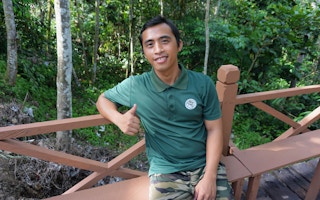Upon graduating, many university students from rural Malaysia dream of leaving their villages and starting a new life in the city. But for Juanan Jamulan, returning to his home town has made his life more fulfilling.
To continue reading, subscribe to Eco‑Business.
There's something for everyone. We offer a range of subscription plans.
- Access our stories and receive our Insights Weekly newsletter with the free EB Member plan.
- Unlock unlimited access to our content and archive with EB Circle.
- Publish your content with EB Premium.
Jamulan hails from Kampung Kaiboton, a remote village in the Beluran district of Sabah, Malaysia. The village is located about three hours from Sandakan and six hours from the state capital, Kota Kinabalu.
The 29 year-old is the fifth of seven siblings and belongs to the Tombonuo tribe, one of 40 Indigenous groups in Sabah. Though the Tombonuon people are known for their deep connection to the mangrove forests near the tidal creeks where traditionally they have lived, Jamulan had no prior experience working in forests or with their inhabitants before becoming a ranger.
He associates forests with insect and leech bites. He is also afraid of snakes. However, since becoming a ranger, he has developed a respect for snakes, which he recognises as an important part of the forest ecosystem.
Jamulan holds a diploma in applied physics from Universiti Teknologi MARA in Sepanggar, Kota Kinabalu. He previously worked as a student placement counsellor at Lincoln University College in the city and as a bird’s nest cleaner at the Borneo Yin Who Factory in Inanam.
When the Covid-19 pandemic hit, Jamulan returned to his village to help manage his family’s oil palm plantation. After several years of city life and formal education, he wanted to find a job near home.
Jamulan told Eco-Business that he initially applied for a role as a document controller with palm oil giant Wilmar at the Sekar Imej Conservation Area (SICA), a regenerating lowland mixed dipterocarp forest spanning 2,469 hectares of logged-over land. Though he did not pass the interview, he was offered a ranger position in August 2022, which he gladly accepted.
Since he had limited knowledge of forests, he had to start learning about these complex ecosystems from scratch in order to do his job. Now in his third year as a ranger, the role has deepened his interest in forests and the dynamic relationship between nature and people. Through this work, he’s found not only a career but a calling.

Jamulan (left) demonstrating a wildlife camera setup at Laimong Peak in SICA. Image Siva Selan / Eco-Business
Among his fellow rangers, Jamulan is affectionately known as “Pastor” due to his volunteer work and his role as a youth instructor at the United Pentecostal Church in Sabah. He also goes by the nickname, “Doctor,” which reflects his keen interest in flora and fauna, particularly nocturnal wildlife. Since joining the SICA scientific expedition in 2022, he has invested his own time and resources into night-spotting equipment, following the guidance of his mentor, Dr Priscillia Miard, a senior lecturer from Universiti Malaysia Sabah (UMS).
Through his ranger duties and involvement in scientific expeditions, Juanan’s love for nature has grown. Today, he aspires to promote SICA to a wider audience and encourage others to appreciate the value of conservation.
Here’s how a typical working day for Jamulan breaks down:
5am
I begin my day early at 5am with a roll call and morning preparations before heading into the forest. We have breakfast and get ready to go on duty for the day.
I often wake up thinking about safety and how to handle the different, unexpected situations that I might face. It’s a mixture of feelings. I feel excited when I encounter something rare and actively seek new experiences.
7am
I leave my village and begin my journey to the designated patrol area. I’m currently stationed at Parcel 4, the second-largest forested section within SICA. It is home to a group of proboscis monkeys, which are not found anywhere else within SICA.
Although they’re not native to this region, I find it interesting that they’ve managed to adapt and thrive here. Typically, proboscis monkeys inhabit riverbanks, especially in mangrove forests and lowland swamp areas, rather than highland terrain like in SICA.
I still remember contacting Professor Hendry Bernard from UMS when I first saw these monkeys to find out how they have come to exist outside their native regions. Since then, this remains one of my big questions: If all habitats are destroyed, where will these animals go?
The trip from my village to Parcel 4 usually takes about an hour by motorcycle, depending on the trail conditions. I often face trouble getting to work when it rains because the trail gets really muddy and hard to navigate using motorcycles. There have been times when my bike has broken down mid-journey, making the day ahead even more challenging.
8am
I start my patrol duties. Tasks for the day include inspecting wildlife camera traps, checking for signs of illegal activity or encroachment, and documenting flora and fauna. I’ve seen signs of encroachment before where our camera traps have been tampered with, and trees cut down. I’ve also seen people wandering around SICA during my patrol. Usually, I approach these people and ask what their intention is and explain that this forest is protected from logging and poaching.

The Malayan giant squirrel (Ratufa bicolor) is one of the largest species of squirrel in the world. An adult has a head and body length of 34 to 37 cm, weighing up to 1.25 kg. The tail is 41 to 42 cm long. Image: Vijay Anand Ismavel / Flickr
Conserving wildlife requires a lot of awareness-building and to help ensure these species remain protected, I do my part by educating the local community about the importance of their existence and why they should be preserved. During my daily patrols, I also make sure the area is free from snares and other traps, which are a major threat to the animals in the park. I personally have experience of removing snares in the forest and I continue to educate the community in my village on the importance of protecting animals. Some have understood it, but others are still struggling to do so.
[Juanan said that he is particularly interested in wild cats since becoming a ranger, and hopes to see images of them on the camera traps. He once came across a Malayan giant squirrel, which he describes as a shocking experience as it was much larger than a regular squirrel and spotting one is rare.]
12pm
After about four hours of patrolling, we get ready to have lunch. Many of us bring packed lunches from home and have them on the forest floor during our little pit stops since there are no restaurants or stalls. We also bring our supplies of drinking water to quench our thirst during the journey. Littering in the forest is a big no, so we always ensure that the forest is free from rubbish and pick up any when we find it.
I’ve always dreamed of starting a project to keep my village clean so that people won’t litter everywhere, especially in the rivers and forests. I believe that a stable ecosystem is key to preventing the spread of diseases.
Usually during breaks, my team and I talk about how the forest used to look before large-scale logging began. There’s a big difference between giant old trees and the small trees you see now. The air used to be fresher and cooler, which naturally helps ease fatigue.
[On days when rangers are required to cover the Monjuk peak, which is the highest peak in SICA, the journey can take up to four hours one way, hiking through dense terrain. These are some of the most challenging hikes for Juanan because of the long distance. It gets even more difficult during heavy rains, strong winds, and heatwaves.]
2pm
I finish my patrolling. I return to the village for personal commitments such as vising the family farm. I also take time to unwind through some of my favourite pastimes such as playing football, jogging, singing and learning foreign languages.
Sometimes, our duties extend beyond the usual schedule. There are days when we have more work to do, such as setting camera traps for wildlife spotting and other ad hoc duties which might require us to stay back at the base camp.

Jamulan’s colleague, Miwes Masital (Ewok) showing the discovery of the host plant for Rafflesia in SICA. Image: Siva Selan / Eco-Business
I enjoy listening to the sounds of the forest at night and watching the moon light up the sky. It often reminds me of the old days when my family and I lived in the forest without electricity, accompanied by the soothing sounds of nature.
Now that I’m a ranger I do carry that mindset with me even when I get home, especially when I hear strange sounds or when I’m on my parent’s farm, thinking that it’s wildlife. I’m always on the lookout for signs of them. This helps me to distinguish between the wildlife in palm plantations and animals in the forest.
[The conservation team recently discovered the host plant species for Rafflesia, or stinking corpse lily, in SICA. This latest finding adds to the growing list of plant species identified in the area. It could be a sign that the rare plant, which has the world’s largest flower, may grow there in the future.]
7pm
We typically spend the evenings with our families if we were not required to stay at the base camp. We have dinner and call it a night, as we need to be up early for the next day.
Being a ranger is not easy because I have to deal with illegal hunters and loggers. There have been moments where I felt like giving up. At times like this, I remind myself why I joined the team. I think about the purpose of my job, my family, and our financial needs.
I often think about the elders telling me stories of how they relied on the forest for clean air, water and food, which reminds me why I do this job. It’s about maintaining a healthy ecosystem for future generations.
Media access to the sponsored SICA expedition was facilitated by Wilmar.














